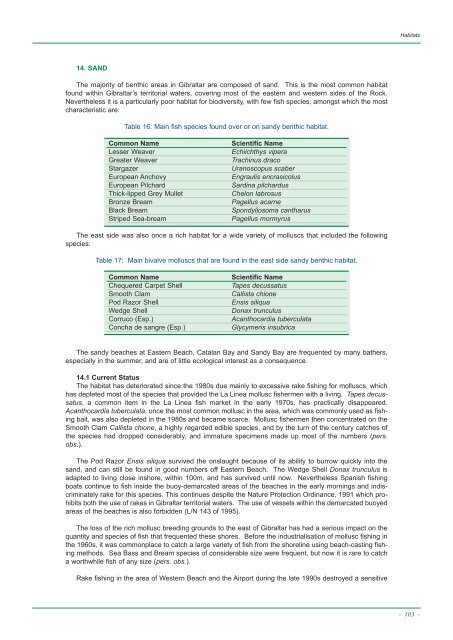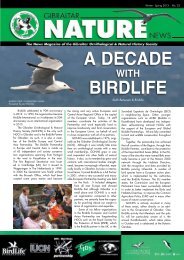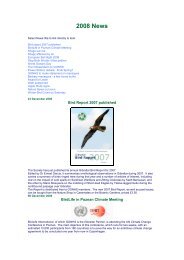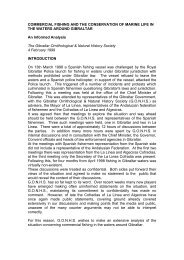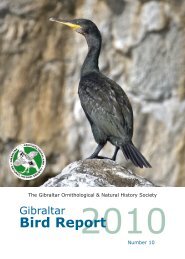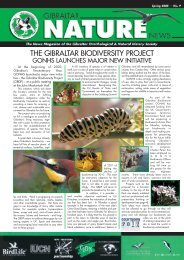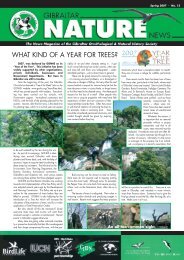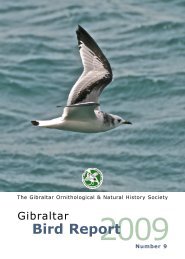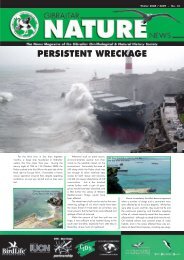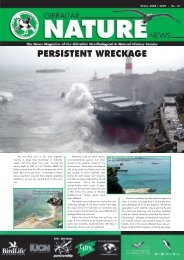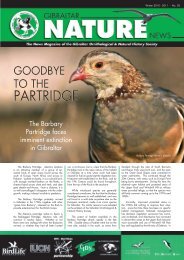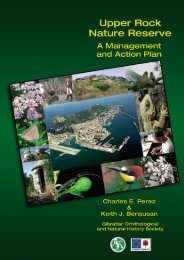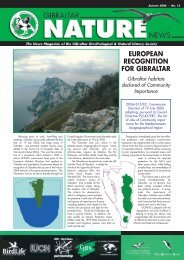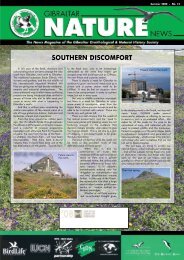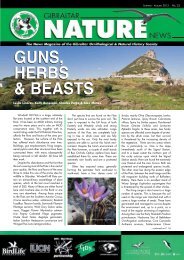Available as a PDF download - Gibraltar Ornithological & Natural ...
Available as a PDF download - Gibraltar Ornithological & Natural ...
Available as a PDF download - Gibraltar Ornithological & Natural ...
Create successful ePaper yourself
Turn your PDF publications into a flip-book with our unique Google optimized e-Paper software.
14. SAND<br />
The majority of benthic are<strong>as</strong> in <strong>Gibraltar</strong> are composed of sand. This is the most common habitat<br />
found within <strong>Gibraltar</strong>’s territorial waters, covering most of the e<strong>as</strong>tern and western sides of the Rock.<br />
Nevertheless it is a particularly poor habitat for biodiversity, with few fish species, amongst which the most<br />
characteristic are:<br />
Table 16: Main fish species found over or on sandy benthic habitat.<br />
Common Name Scientific Name<br />
Lesser Weaver Echiichthys vipera<br />
Greater Weaver Trachinus draco<br />
Stargazer Uranoscopus scaber<br />
European Anchovy Engraulis encr<strong>as</strong>icolus<br />
European Pilchard Sardina pilchardus<br />
Thick-lipped Grey Mullet Chelon labrosus<br />
Bronze Bream Pagellus acarne<br />
Black Bream Spondyliosoma cantharus<br />
Striped Sea-bream Pagellus mormyrus<br />
The e<strong>as</strong>t side w<strong>as</strong> also once a rich habitat for a wide variety of molluscs that included the following<br />
species:<br />
Table 17: Main bivalve molluscs that are found in the e<strong>as</strong>t side sandy benthic habitat.<br />
Common Name Scientific Name<br />
Chequered Carpet Shell Tapes decussatus<br />
Smooth Clam Callista chione<br />
Pod Razor Shell Ensis siliqua<br />
Wedge Shell Donax trunculus<br />
Corruco (Esp.) Acanthocardia tuberculata<br />
Concha de sangre (Esp.) Glycymeris insubrica<br />
The sandy beaches at E<strong>as</strong>tern Beach, Catalan Bay and Sandy Bay are frequented by many bathers,<br />
especially in the summer, and are of little ecological interest <strong>as</strong> a consequence.<br />
14.1 Current Status<br />
The habitat h<strong>as</strong> deteriorated since the 1980s due mainly to excessive rake fishing for molluscs, which<br />
h<strong>as</strong> depleted most of the species that provided the La Linea mollusc fishermen with a living. Tapes decussatus,<br />
a common item in the La Linea fish market in the early 1970s, h<strong>as</strong> practically disappeared.<br />
Acanthocardia tuberculata, once the most common mollusc in the area, which w<strong>as</strong> commonly used <strong>as</strong> fishing<br />
bait, w<strong>as</strong> also depleted in the 1980s and became scarce. Mollusc fishermen then concentrated on the<br />
Smooth Clam Callista chione, a highly regarded edible species, and by the turn of the century catches of<br />
the species had dropped considerably, and immature specimens made up most of the numbers (pers.<br />
obs.).<br />
The Pod Razor Ensis siliqua survived the onslaught because of its ability to burrow quickly into the<br />
sand, and can still be found in good numbers off E<strong>as</strong>tern Beach. The Wedge Shell Donax trunculus is<br />
adapted to living close inshore, within 100m, and h<strong>as</strong> survived until now. Nevertheless Spanish fishing<br />
boats continue to fish inside the buoy-demarcated are<strong>as</strong> of the beaches in the early mornings and indiscriminately<br />
rake for this species. This continues despite the Nature Protection Ordinance, 1991 which prohibits<br />
both the use of rakes in <strong>Gibraltar</strong> territorial waters. The use of vessels within the demarcated buoyed<br />
are<strong>as</strong> of the beaches is also forbidden (L/N 143 of 1995).<br />
The loss of the rich mollusc breeding grounds to the e<strong>as</strong>t of <strong>Gibraltar</strong> h<strong>as</strong> had a serious impact on the<br />
quantity and species of fish that frequented these shores. Before the industrialisation of mollusc fishing in<br />
the 1960s, it w<strong>as</strong> commonplace to catch a large variety of fish from the shoreline using beach-c<strong>as</strong>ting fishing<br />
methods. Sea B<strong>as</strong>s and Bream species of considerable size were frequent, but now it is rare to catch<br />
a worthwhile fish of any size (pers. obs.).<br />
Rake fishing in the area of Western Beach and the Airport during the late 1990s destroyed a sensitive<br />
Habitats<br />
- 103 -


